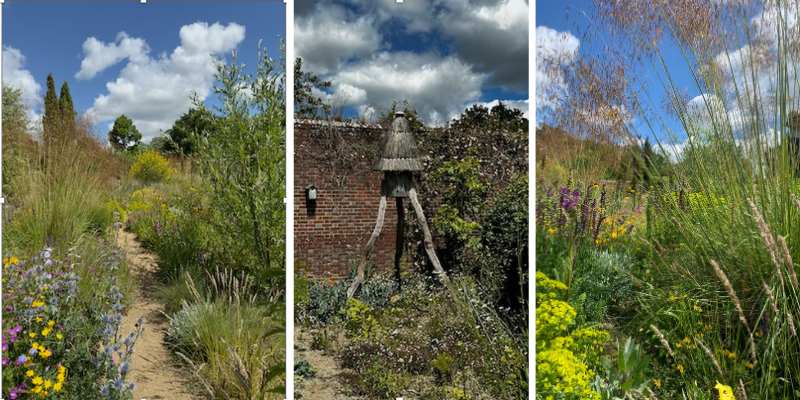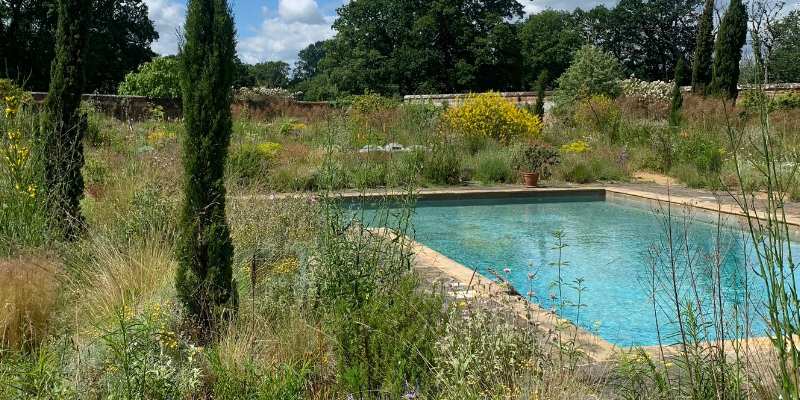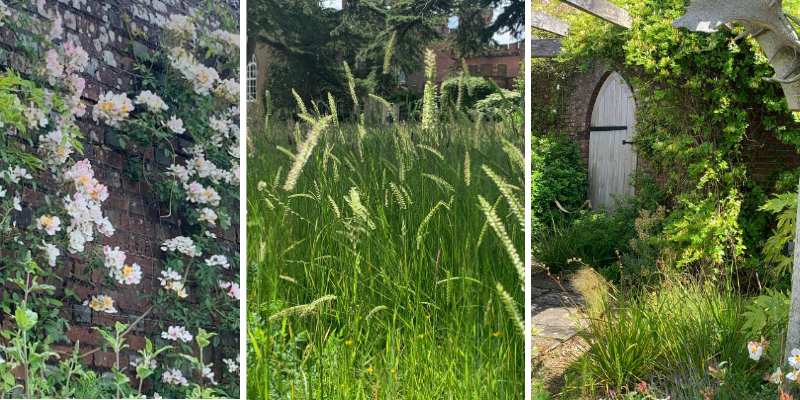Entering Narnia - the magical Walled Garden at Knepp

A long read – but worth it!
Re-Betchworth organised a 20-person visit to the Walled Garden at the Knepp Estate, pioneer of rewilding in the UK to explore interest in and knowledge about wild and nature-friendly gardening. Claire Benn reports
It was mid-June, and a day of glorious weather in a stunning and fascinating location. Susie (one of two Assistant Head Gardeners) kicked off the day with a brief history of Knepp’s re-wilding journey. She followed up with a more detailed presentation giving us the background to the more recent transformation of the formal walled garden, the walled vegetable garden and the wildflower meadow.
Fascinating as it was, the presentation couldn’t truly prepare us for what was on offer. Entering through a small door set in the main gate felt like stepping into the Secret Garden or, as one person put it, going into the wardrobe and finding yourself in Narnia.
The formal Walled Garden was originally designed with a pool, a croquet lawn, some trees and traditional herbaceous borders. In anticipation of climate change bringing Barcelona weather to the south-east of England, a decision was made to transform the space into a naturalistic dry garden. The walls offer shelter from the roaming, grazing animals of Knepp and the winds, making this area ideal for drought-tolerant plants.
The project was master-minded by James Hitchmough and Tom Stewart-Smith who divided up the space and designed complementary planting schemes to flow and work well together. They made use of demolished, derelict, concrete outbuildings on the estate, crushing the concrete and mixing it with sand. This provided a new, low-fertility, free-draining planting substrate which was introduced to the Walled Garden.
One part of the site was excavated to a depth of 1.8m while other areas were built up to a height of 1.8m. This created hills and valleys, with the excavated area providing a space for plants that prefer damp(er) conditions. Although it does dry out in high summer, it still offers a cooler, more damp refuge for wildlife.
The hard landscaping used two mixes of ‘soil’; some being an equal mix of crushed concrete and sand and others a mix of 75% concrete to 25% sand.
An impressive 16,000 plants were then bedded into the mix and seed was scattered. The space was watered for six weeks; after that, things were left to fend for themselves. Susie told us that due to the loose nature of the soil mix, planting was easy and relatively quick. The team were astonished at how quickly and well the plants established themselves in such a low-nutrient, free-draining substrate.
The space is divided by meandering, undulating paths with no hard edges in sight. Although maintenance is done to maintain a good variety of plants, weeding is carried out in a manner to mimic animal grazing and plants are left to stand throughout the winter to provide visual interest and shelter.

The space is breath-taking, full of colour, texture and life. We were curious about the continued existence of the heated swimming pool; Susie admitted it was the elephant in the room, explaining that the cost of removing and replacing it with a natural pond or pool had proved prohibitive. She also reminded us that Knepp is still a family home and Isabella and James, having already done so much to return Knepp to nature, were to be forgiven for allowing themselves and their family the continued indulgence of the pool.

It’s easy to imagine loafing about in this idyllic space - glass of wine and book by your side – although I think the simple act of looking would be enough to keep me occupied for hours.
Susie then took us to the newly established meadow by the main house. Plenty of Yellow Rattle was in evidence, which will predate on the grasses and help create more room for native wildflowers. The meadow is cut between mid to end of August and some cuttings are strewn elsewhere to drop seed and expand the meadow. Stooks are also formed from the cuttings to create winter hibernation homes for wildlife, something we might try with our own meadow cuttings this year.
We doubled back from the meadow to enter the walled vegetable garden, encountering a rather funky bee and insect apartment block to our right.
Knepp takes a no-dig approach and planting areas have had their edges softened to encourage low-growing herbs and edible flowers to flourish. The old walls are a delightful mix of roses and other flowering climbers, interspersed with (loosely) trained soft fruit and fruit trees.
Mulching plays a key role and water is provided by a 20,000L rainwater collection tank. As with the dry walled garden, weeding is designed to mimic grazing animals - evidenced by Tom Stewart-Smith’s goat-grazed yew!
Annie and her team take edible flowers, herbs, salad and veg to the Wilding Café every day which supplements the produce now being grown in a newly-established Market Garden area. We all had lunch in this new café area – good food, and a lovely setting.

Everyone left Knepp with a sense of wonderment, and maybe inspired to consider what transformational changes could be made to their own gardens, of whatever size. I believe that everyone who visited would agree that these approaches (in the long term) mean less work, less water usage, more bio-diversity and safe havens for wildlife – and can also be stunningly beautiful. They offer us the chance to live in greater harmony with the natural world… and help us to adapt to the conditions our changing climate is bringing.